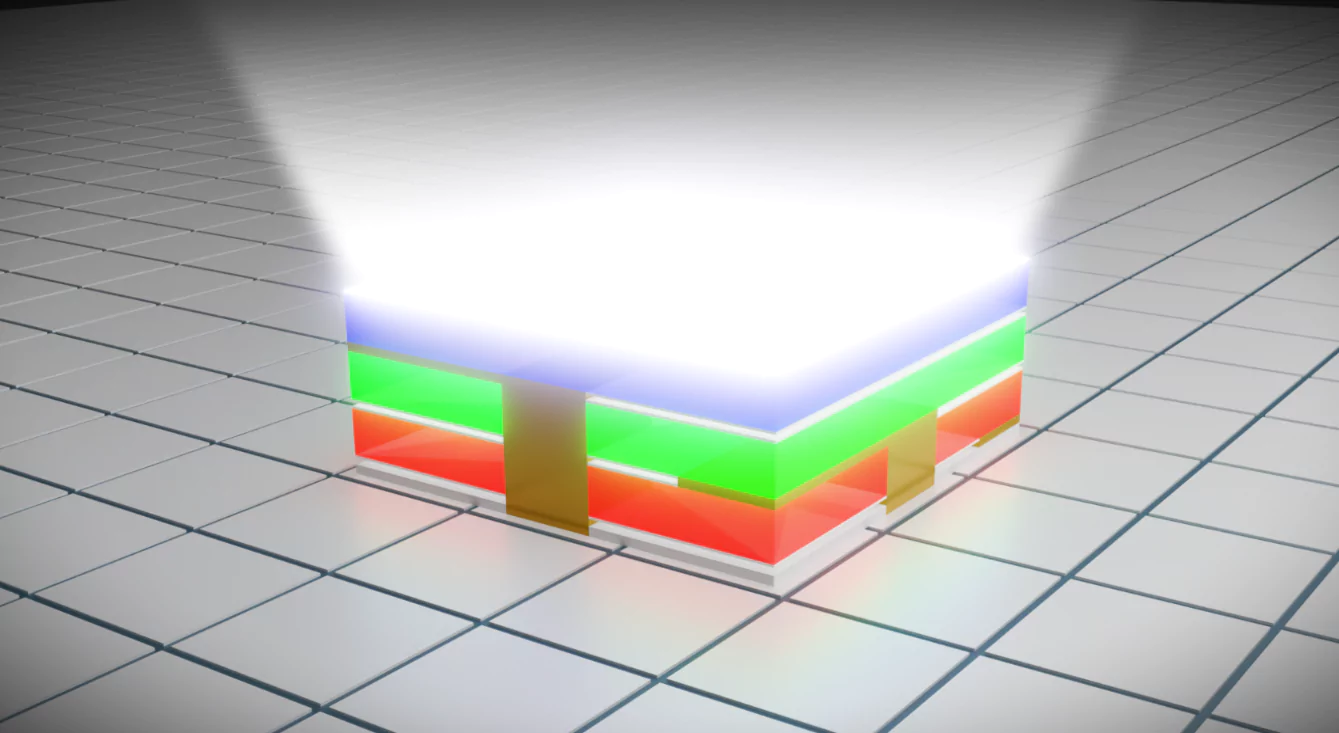HONG KONG– Following Apple’s recent launch of mixed reality (MR) glasses, the importance of microdisplay technology has come to the forefront. Microdisplays are a critical and costly component of visual systems for virtual, augmented, and mixed reality applications.
“Apple’s venture into mixed reality, albeit remarkable, is tethered to MicroOLED displays. These come with their baggage—like soaring costs, compromised brightness, and longevity concerns,” shared Dr. Eddy Hsu, the co-founder of the influential Rayleigh Vision with over 20-year experience in Micro-LED displays.
The microdisplay research team, led by Professor Jr-Hau HE at City University of Hong Kong and its spin-off company Rayleigh Vision, has made significant advancements in Micro-LED technology to overcome the current limitations. Their newly announced two-layer microdisplay array showing a disruptive stacking technology, to craft dual-layer units where each layer can modulate colors independently. The team’s stacking approach has gained initial validation and is on track to cultivate an RGB full-color Micro-LED. This advancement is expected to quadruple pixel density by the end of 2023. This product boasts high contrast, high brightness, wide color gamut, high efficiency, low power consumption, and long lifetime, making it suitable for a wide range of applications in entertainment, consumer electronics, and professional industries.
 Illustrative graphic of Rayleigh Vision’s developing 3-layer stacked Micro-LED chip.
Illustrative graphic of Rayleigh Vision’s developing 3-layer stacked Micro-LED chip.
With hubs in California, Hong Kong, and Taiwan, it’s Rayleigh Vision’s approach to Micro-LEDs that has industry insiders talking. The team has launched several innovative products, such as the 0.55” full-color Micro-LED microdisplay and an impressive 0.38” Micro-LED microdisplay boasting a pixel density of 3780 ppi. Moreover, by achieving a technological feat in successfully cultivating 2.5 μm Micro-LED pixels and building a pixel array with a staggering density exceeding 10,000 ppi, Rayleigh Vision become one of the select teams in the market capable of harnessing this cutting-edge technology.

The research team’s 0.55” Micro-LED display in 2020, showcasing its logos.
Under Rayleigh Vision’s banner, significant advancements are underway. “At Rayleigh Vision, we’ve achieved exceptional pixel densities and are redefining Micro-LED displays. We integrate top-tier micro-LED design, advanced semiconductor processes, and innovative techniques in mass transfer and wafer-scale inspection. Additionally, we hold patents to safeguard our technology,” said Dr. He, highlighting the company’s leadership in the domain.
The team’s broader vision is not just about technology. “Beyond technical milestones, Rayleigh Vision is committed to shaping a robust Micro-LED supply ecosystem, thereby transforming the tech landscape and significantly influencing advancements in the AR/VR/MR realm.” Dr. He added, emphasizing their contribution to the industry. Rayleigh Vision’s innovative products have garnered interest from global electronics powerhouses like Foxconn, ZTE, and Huawei. These companies are delving into the potential of Micro-LED microdisplays for AR/VR/MR glasses and other advanced wearable spatial computing devices.
Micro-LEDs are generating increasing excitement, with projections indicating that the market could skyrocket from $500 million in 2022 to a staggering $20 billion by 2027. The allure of this emergent tech hasn’t gone unnoticed, as evidenced by the significant investments made last year. Over 20 companies collectively contributed almost $2 billion to advance Micro-LED tech, including Google’s substantial $1 billion acquisition of the startup Raxium in 2022.
In the midst of fierce competition, various innovative technologies are crucial for the development of Micro-LED. Among them, the latest stacking technology introduced by Rayleigh Vision is considered by industry experts to hold the potential to redefine the market landscape.
About Rayleigh Visions
2023 marked the inception of Rayleigh Vision, an avant-garde in the micro-LED sector. The company is built upon a robust foundation of seasoned micro-LED connoisseurs, with each member having an average of 15 years of working experience across a spectrum of domains—ranging from materials and circuits to applications, systems, and strategic marketing.
This technological powerhouse has not only amassed an impressive portfolio of over 300 patents through its founders but is also trailblazing the path to innovation. One of Rayleigh Vision’s most notable advancements is its pioneering stacking micro-LED technology. This innovation is a game-changer, offering enhanced pixel density, augmented energy efficiency, and a cost-effective solution, shaping the future of AR/VR/MR, smartwatches, mobile devices, and even the automotive display sector.
Further strengthening their technological prowess, Rayleigh Vision has already filed for 12 proprietary patents, showcasing its commitment to lead and not just follow. As the world moves toward a tech-integrated future, Rayleigh Vision is poised to set the gold standard in the micro-LED industry.
